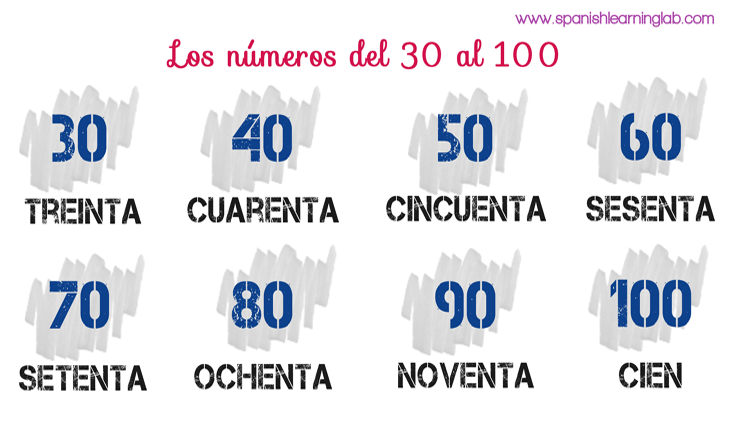In the previous lesson, we learned how to write and use numbers from 1 to 20. In this one, you will learn the basics pattern for writing and saying numbers in Spanish from 20 to 100, “los números del 20 al 100”. The lesson includes several examples of common questions and phrases with numbers in Spanish, besides a video with simple explanations and many other interesting resources that will show you how to use numbers in real situations. Let’s begin…
Introductory video: Writing and saying numbers in Spanish 1-100
We will begin the lesson by watching a short video. This video will present several drawings related to numbers in Spanish 1-100, as well as sentences with these numbers. It also explains some basic patterns related to numbers and introduces new questions and expressions. Do not worry if you cannot remember the vocabulary easily as we will provide more examples later. Please activate the captions (cc) below if you need the English translation.
Making sentences with numbers in Spanish 20-100
How to write and say numbers in Spanish 20-30
In order to write and say numbers in Spanish 20-30, we will follow a very simple pattern, which consists of the prefix VEINTI- plus a digit from one to nine, “un dígito del uno al nueve”. As an illustration, let’s take the number twenty-two. The “twenty” part will be translated as VEINTI- so we simply need to add the number DOS and say “VEINTIDOS”, making a single word out of two numbers. The key is to know how to use numbers from one to ten in Spanish. Know that the number twenty by itself will be written as “VEINTE”.
Listen to some sentences with numbers in Spanish from 20 to 30 below and the way they can be used to count people, say prices and tell others how old you are.
|
VEINTE – Hay veinte personas en la clase
There are 20 people in the class
|
|
VEINTIUNO – Yo tengo el número veintiuno
I have the number twenty one
|
|
VEINTICINCO – ¿Tú tienes veinticinco años?
Are you twenty five years old?
|
|
VEINTISIETE- Esta camisa vale veintisiete dólares
This shirt is twenty seven dollars
|
|
TREINTA – La empresa tiene treinta trabajadores.
The empresa has thirty workers
|
How to write and say numbers in Spanish 30-100
In order to write and say most numbers in Spanish after 30, we will first have to learn the tens, that is “TREINTA”, “CUARENTA”, “CINCUENTA” and so on. These words are the basis to form numbers from 30 through 100. For number in between 30 and 40, for instance, we will write the ten e.g. TREINTA, then we will add the conjunction “Y” in the middle and finally a digit from 1 to 9.

As an example, the number “thirty-four” is composed of the ten TREINTA and the digit CUATRO so we can write this number as “Treinta y cuatro”. Notice that unlike Spanish numbers like “VEINTIUNO”, we must write the numbers independently so writing “TREINTAYCUATRO” would be incorrect. Below, you can read and listen to some sentences using numbers in Spanish from 30 to 100. Check how the rules we explained are applied in the examples.
|
TREINTA Y CINCO – Treinta y cinco razones para estudiar español
Thirty five reasons to study Spanish
|
|
CUARENTA – Hay cuarenta personas en la clase.
There are forty people in the class
|
|
CUARENTA Y SIETE – Mi mamá tiene cuarenta y siete años
My mother is 47 years old
|
|
CINCUENTA – ¿Podrías prestarme cincuenta dólares?
Could you lend me 50 dollars?
|
|
SESENTA – Una hora tiene sesenta minutos
An hour has 60 minutes
|
|
SETENTA – Hay setenta posibilidades.
There are 70 possibilities
|
|
OCHENTA – Un pueblo pequeño con ochenta casas
A small town with 80 houses
|
|
NOVENTA – Mi teléfono tiene noventa aplicaciones.
My phone has 90 apps
|
|
NOVENTA Y NUEVE – El Noventa y nueve está cerca del cien
99 is close to 100
|
|
CIEN – Así que aprendiste cien números.
So you learned 100 numbers
|
Closing remarks and exercises with Spanish Numbers 20-100
As you can see from all the examples provided in the lesson, numbers in Spanish 20-100 and actually all numbers in the language are really useful for many different purposes. It often takes years for kids to learn numbers from 1 to 100. Constant practice is the key to master this topic. Make sure you also find real situations in which you can use Spanish numbers. Our example should guide you to create your own. Before you go, test yourself with the quiz below. ¡Buena suerte! ¡Hasta pronto!
Related PDF Worksheets:
- Numbers in Spanish from 1 to 20
- Numbers in Spanish from 20 to 100
- Ordinal Numbers in Spanish
- Spanish Numbers 1-20 – PDF Word Search
- Numbers in Spanish 1 to 100 (Matching + sentences)
- Numbers over 100 in Spanish (Matching + sentences)
